Jiaxuan Li
Amazon
A Universal Banach--Bregman Framework for Stochastic Iterations: Unifying Stochastic Mirror Descent, Learning and LLM Training
Sep 17, 2025Abstract:Stochastic optimization powers the scalability of modern artificial intelligence, spanning machine learning, deep learning, reinforcement learning, and large language model training. Yet, existing theory remains largely confined to Hilbert spaces, relying on inner-product frameworks and orthogonality. This paradigm fails to capture non-Euclidean settings, such as mirror descent on simplices, Bregman proximal methods for sparse learning, natural gradient descent in information geometry, or Kullback--Leibler-regularized language model training. Unlike Euclidean-based Hilbert-space methods, this approach embraces general Banach spaces. This work introduces a pioneering Banach--Bregman framework for stochastic iterations, establishing Bregman geometry as a foundation for next-generation optimization. It (i) provides a unified template via Bregman projections and Bregman--Fejer monotonicity, encompassing stochastic approximation, mirror descent, natural gradient, adaptive methods, and mirror-prox; (ii) establishes super-relaxations ($\lambda > 2$) in non-Hilbert settings, enabling flexible geometries and elucidating their acceleration effect; and (iii) delivers convergence theorems spanning almost-sure boundedness to geometric rates, validated on synthetic and real-world tasks. Empirical studies across machine learning (UCI benchmarks), deep learning (e.g., Transformer training), reinforcement learning (actor--critic), and large language models (WikiText-2 with distilGPT-2) show up to 20% faster convergence, reduced variance, and enhanced accuracy over classical baselines. These results position Banach--Bregman geometry as a cornerstone unifying optimization theory and practice across core AI paradigms.
Six-DoF Hand-Based Teleoperation for Omnidirectional Aerial Robots
Jun 17, 2025Abstract:Omnidirectional aerial robots offer full 6-DoF independent control over position and orientation, making them popular for aerial manipulation. Although advancements in robotic autonomy, operating by human remains essential in complex aerial environments. Existing teleoperation approaches for multirotors fail to fully leverage the additional DoFs provided by omnidirectional rotation. Additionally, the dexterity of human fingers should be exploited for more engaged interaction. In this work, we propose an aerial teleoperation system that brings the omnidirectionality of human hands into the unbounded aerial workspace. Our system includes two motion-tracking marker sets -- one on the shoulder and one on the hand -- along with a data glove to capture hand gestures. Using these inputs, we design four interaction modes for different tasks, including Spherical Mode and Cartesian Mode for long-range moving as well as Operation Mode and Locking Mode for precise manipulation, where the hand gestures are utilized for seamless mode switching. We evaluate our system on a valve-turning task in real world, demonstrating how each mode contributes to effective aerial manipulation. This interaction framework bridges human dexterity with aerial robotics, paving the way for enhanced teleoperated aerial manipulation in unstructured environments.
CSPENet: Contour-Aware and Saliency Priors Embedding Network for Infrared Small Target Detection
May 15, 2025Abstract:Infrared small target detection (ISTD) plays a critical role in a wide range of civilian and military applications. Existing methods suffer from deficiencies in the localization of dim targets and the perception of contour information under dense clutter environments, severely limiting their detection performance. To tackle these issues, we propose a contour-aware and saliency priors embedding network (CSPENet) for ISTD. We first design a surround-convergent prior extraction module (SCPEM) that effectively captures the intrinsic characteristic of target contour pixel gradients converging toward their center. This module concurrently extracts two collaborative priors: a boosted saliency prior for accurate target localization and multi-scale structural priors for comprehensively enriching contour detail representation. Building upon this, we propose a dual-branch priors embedding architecture (DBPEA) that establishes differentiated feature fusion pathways, embedding these two priors at optimal network positions to achieve performance enhancement. Finally, we develop an attention-guided feature enhancement module (AGFEM) to refine feature representations and improve saliency estimation accuracy. Experimental results on public datasets NUDT-SIRST, IRSTD-1k, and NUAA-SIRST demonstrate that our CSPENet outperforms other state-of-the-art methods in detection performance. The code is available at https://github.com/IDIP2025/CSPENet.
SPACER: A Parallel Dataset of Speech Production And Comprehension of Error Repairs
Mar 20, 2025
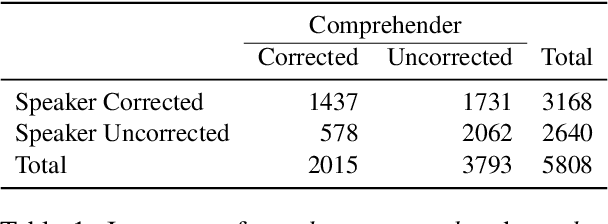
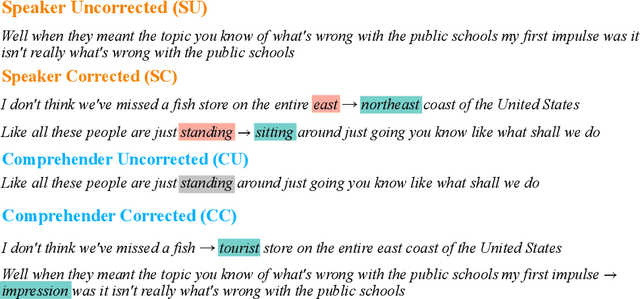
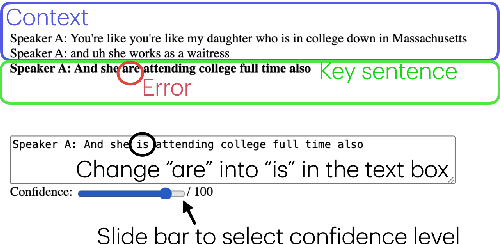
Abstract:Speech errors are a natural part of communication, yet they rarely lead to complete communicative failure because both speakers and comprehenders can detect and correct errors. Although prior research has examined error monitoring and correction in production and comprehension separately, integrated investigation of both systems has been impeded by the scarcity of parallel data. In this study, we present SPACER, a parallel dataset that captures how naturalistic speech errors are corrected by both speakers and comprehenders. We focus on single-word substitution errors extracted from the Switchboard corpus, accompanied by speaker's self-repairs and comprehenders' responses from an offline text-editing experiment. Our exploratory analysis suggests asymmetries in error correction strategies: speakers are more likely to repair errors that introduce greater semantic and phonemic deviations, whereas comprehenders tend to correct errors that are phonemically similar to more plausible alternatives or do not fit into prior contexts. Our dataset enables future research on integrated approaches toward studying language production and comprehension.
CFFormer: Cross CNN-Transformer Channel Attention and Spatial Feature Fusion for Improved Segmentation of Low Quality Medical Images
Jan 07, 2025Abstract:Hybrid CNN-Transformer models are designed to combine the advantages of Convolutional Neural Networks (CNNs) and Transformers to efficiently model both local information and long-range dependencies. However, most research tends to focus on integrating the spatial features of CNNs and Transformers, while overlooking the critical importance of channel features. This is particularly significant for model performance in low-quality medical image segmentation. Effective channel feature extraction can significantly enhance the model's ability to capture contextual information and improve its representation capabilities. To address this issue, we propose a hybrid CNN-Transformer model, CFFormer, and introduce two modules: the Cross Feature Channel Attention (CFCA) module and the X-Spatial Feature Fusion (XFF) module. The model incorporates dual encoders, with the CNN encoder focusing on capturing local features and the Transformer encoder modeling global features. The CFCA module filters and facilitates interactions between the channel features from the two encoders, while the XFF module effectively reduces the significant semantic information differences in spatial features, enabling a smooth and cohesive spatial feature fusion. We evaluate our model across eight datasets covering five modalities to test its generalization capability. Experimental results demonstrate that our model outperforms current state-of-the-art (SOTA) methods, with particularly superior performance on datasets characterized by blurry boundaries and low contrast.
NEMO: Can Multimodal LLMs Identify Attribute-Modified Objects?
Nov 26, 2024Abstract:Multimodal Large Language Models (MLLMs) have made notable advances in visual understanding, yet their abilities to recognize objects modified by specific attributes remain an open question. To address this, we explore MLLMs' reasoning capabilities in object recognition, ranging from commonsense to beyond-commonsense scenarios. We introduce a novel benchmark, NEMO, which comprises 900 images of origiNal fruits and their corresponding attributE-MOdified ones; along with a set of 2,700 questions including open-, multiple-choice-, unsolvable types. We assess 26 recent open-sourced and commercial models using our benchmark. The findings highlight pronounced performance gaps in recognizing objects in NEMO and reveal distinct answer preferences across different models. Although stronger vision encoders improve performance, MLLMs still lag behind standalone vision encoders. Interestingly, scaling up the model size does not consistently yield better outcomes, as deeper analysis reveals that larger LLMs can weaken vision encoders during fine-tuning. These insights shed light on critical limitations in current MLLMs and suggest potential pathways toward developing more versatile and resilient multimodal models.
Decomposition of surprisal: Unified computational model of ERP components in language processing
Sep 10, 2024Abstract:The functional interpretation of language-related ERP components has been a central debate in psycholinguistics for decades. We advance an information-theoretic model of human language processing in the brain in which incoming linguistic input is processed at first shallowly and later with more depth, with these two kinds of information processing corresponding to distinct electroencephalographic signatures. Formally, we show that the information content (surprisal) of a word in context can be decomposed into two quantities: (A) heuristic surprise, which signals shallow processing difficulty for a word, and corresponds with the N400 signal; and (B) discrepancy signal, which reflects the discrepancy between shallow and deep interpretations, and corresponds to the P600 signal. Both of these quantities can be estimated straightforwardly using modern NLP models. We validate our theory by successfully simulating ERP patterns elicited by a variety of linguistic manipulations in previously-reported experimental data from six experiments, with successful novel qualitative and quantitative predictions. Our theory is compatible with traditional cognitive theories assuming a `good-enough' heuristic interpretation stage, but with a precise information-theoretic formulation. The model provides an information-theoretic model of ERP components grounded on cognitive processes, and brings us closer to a fully-specified neuro-computational model of language processing.
ESP-MedSAM: Efficient Self-Prompting SAM for Universal Domain-Generalized Medical Image Segmentation
Jul 19, 2024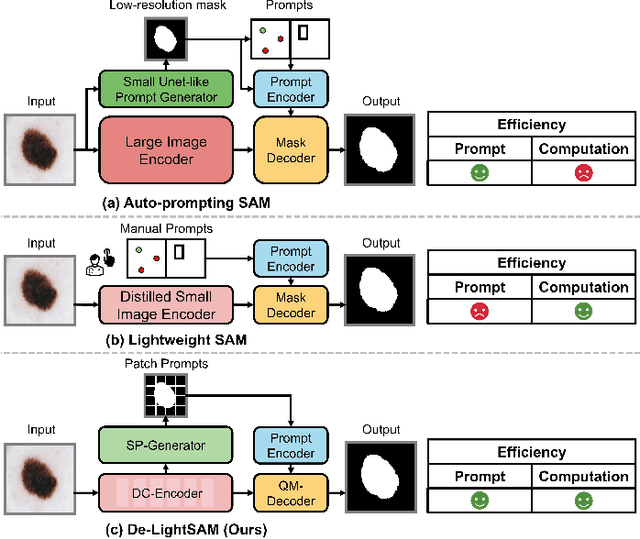

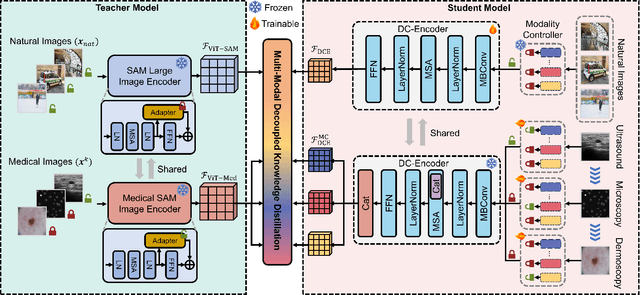
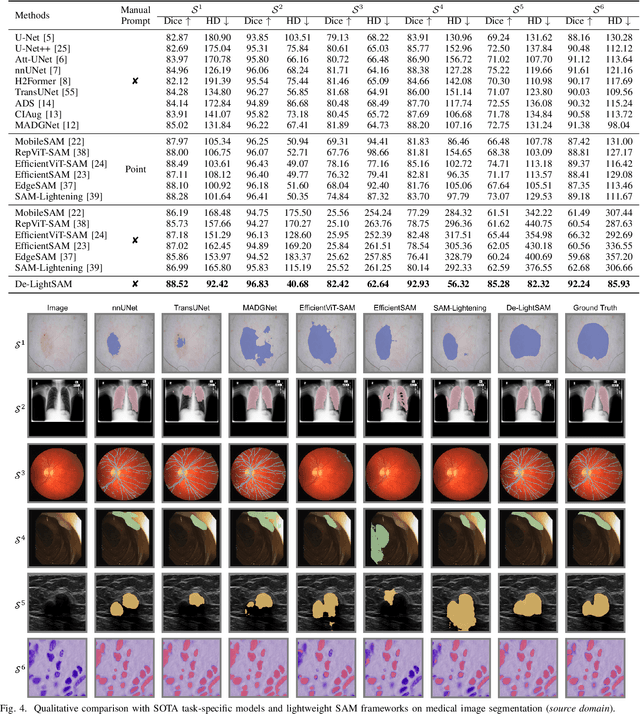
Abstract:The Segment Anything Model (SAM) has demonstrated outstanding adaptation to medical image segmentation but still faces three major challenges. Firstly, the huge computational costs of SAM limit its real-world applicability. Secondly, SAM depends on manual annotations (e.g., points, boxes) as prompts, which are laborious and impractical in clinical scenarios. Thirdly, SAM handles all segmentation targets equally, which is suboptimal for diverse medical modalities with inherent heterogeneity. To address these issues, we propose an Efficient Self-Prompting SAM for universal medical image segmentation, named ESP-MedSAM. We devise a Multi-Modal Decoupled Knowledge Distillation (MMDKD) strategy to distil common image knowledge and domain-specific medical knowledge from the foundation model to train a lightweight image encoder and a modality controller. Further, they combine with the additionally introduced Self-Patch Prompt Generator (SPPG) and Query-Decoupled Modality Decoder (QDMD) to construct ESP-MedSAM. Specifically, SPPG aims to generate a set of patch prompts automatically and QDMD leverages a one-to-one strategy to provide an independent decoding channel for every modality. Extensive experiments indicate that ESP-MedSAM outperforms state-of-the-arts in diverse medical imaging segmentation takes, displaying superior zero-shot learning and modality transfer ability. Especially, our framework uses only 31.4% parameters compared to SAM-Base.
An information-theoretic model of shallow and deep language comprehension
May 13, 2024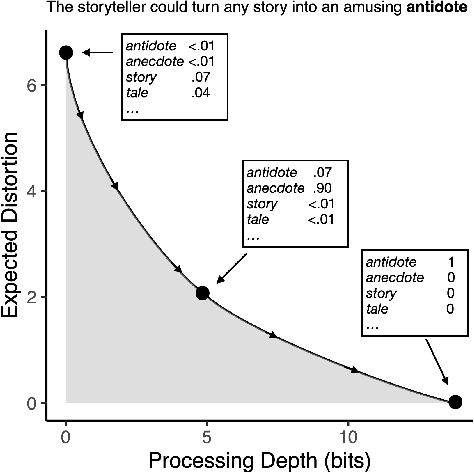
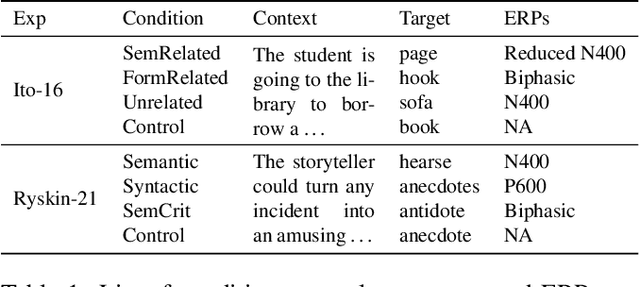
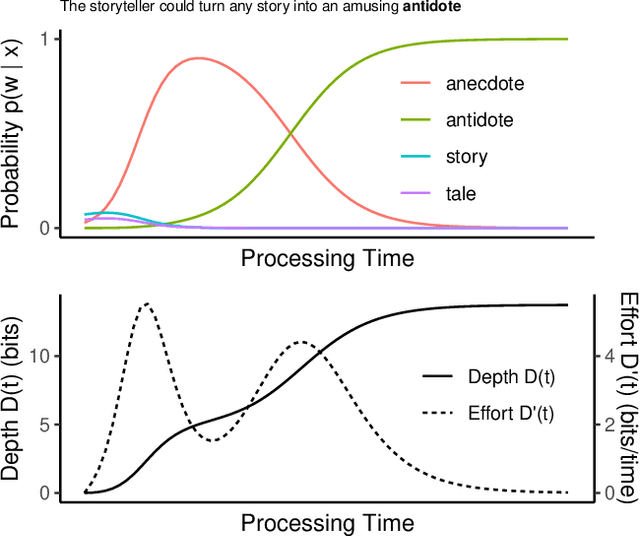
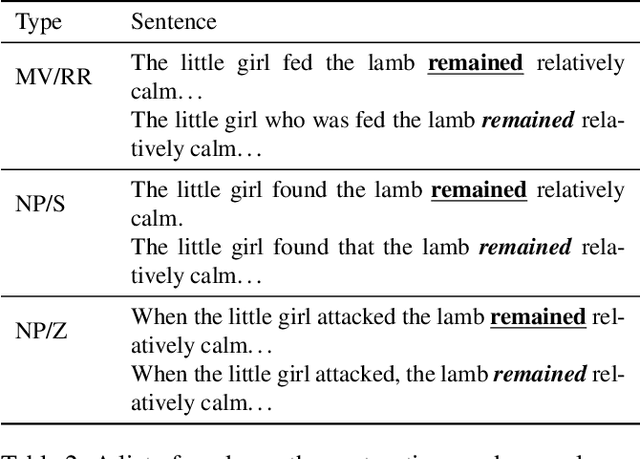
Abstract:A large body of work in psycholinguistics has focused on the idea that online language comprehension can be shallow or `good enough': given constraints on time or available computation, comprehenders may form interpretations of their input that are plausible but inaccurate. However, this idea has not yet been linked with formal theories of computation under resource constraints. Here we use information theory to formulate a model of language comprehension as an optimal trade-off between accuracy and processing depth, formalized as bits of information extracted from the input, which increases with processing time. The model provides a measure of processing effort as the change in processing depth, which we link to EEG signals and reading times. We validate our theory against a large-scale dataset of garden path sentence reading times, and EEG experiments featuring N400, P600 and biphasic ERP effects. By quantifying the timecourse of language processing as it proceeds from shallow to deep, our model provides a unified framework to explain behavioral and neural signatures of language comprehension.
OpenEval: Benchmarking Chinese LLMs across Capability, Alignment and Safety
Mar 18, 2024



Abstract:The rapid development of Chinese large language models (LLMs) poses big challenges for efficient LLM evaluation. While current initiatives have introduced new benchmarks or evaluation platforms for assessing Chinese LLMs, many of these focus primarily on capabilities, usually overlooking potential alignment and safety issues. To address this gap, we introduce OpenEval, an evaluation testbed that benchmarks Chinese LLMs across capability, alignment and safety. For capability assessment, we include 12 benchmark datasets to evaluate Chinese LLMs from 4 sub-dimensions: NLP tasks, disciplinary knowledge, commonsense reasoning and mathematical reasoning. For alignment assessment, OpenEval contains 7 datasets that examines the bias, offensiveness and illegalness in the outputs yielded by Chinese LLMs. To evaluate safety, especially anticipated risks (e.g., power-seeking, self-awareness) of advanced LLMs, we include 6 datasets. In addition to these benchmarks, we have implemented a phased public evaluation and benchmark update strategy to ensure that OpenEval is in line with the development of Chinese LLMs or even able to provide cutting-edge benchmark datasets to guide the development of Chinese LLMs. In our first public evaluation, we have tested a range of Chinese LLMs, spanning from 7B to 72B parameters, including both open-source and proprietary models. Evaluation results indicate that while Chinese LLMs have shown impressive performance in certain tasks, more attention should be directed towards broader aspects such as commonsense reasoning, alignment, and safety.
 Add to Chrome
Add to Chrome Add to Firefox
Add to Firefox Add to Edge
Add to Edge